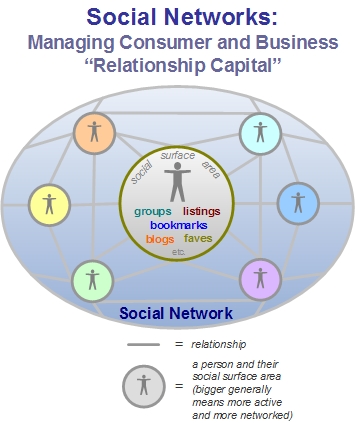Social networking makes a play for the enterprise

While surely inevitable, investors have taken a recent interest in capitalizing on the social network phenomenon, as represented today by the likes of online social giants MySpace and Facebook. MySpace alone has been absorbing the daily attentions of tens of millions of young people over the last year, and is growing at a truly staggering rate. The very last thing that enterprises want these days is a MySpace-style time waster that disrupts business.Facebook actually just launched in January and is already one of the leading social networking sites.
Social networking has clearly hit the big time and is demonstrating both the widespread interest, and the possibilities, of online social communities where people come together to exchange information, develop interpersonal relationships, and build long-term social networks.
This is certainly part of the promise of Web 2.0; a two-way Web powered by people and the information they bring to the table (this latter piece is something I like to call BYOC, or bring-your-own-content.) Of course, the business world already has some relatively successful social networks of its own. LinkedIn is probably the pre-eminent example today, and to a lesser extent, Orkut.
But neither of these come close to rivaling MySpace (now reportedly the #2 site on the entire Web now) or it's seemingly relentless growth and staying power. Month after month, the fad seems to be turning into a serious trend. But LinkedIn and Orkut also don't claim to compete in terms of features and purpose with consumer social networks. So the compelling question is: What if enterprises could somehow capitalize on the social networking power of sites like MySpace and Facebook?
A corporate version of MySpace?
Along this line of thinking, a widely covered new article in BusinessWeek explores the new well-funded startup Visible Path, a social networking service for businesses which it refers to as Relationship Capital Management, or RCM. Visible Path's value proposition is that they can roll up the overall value of social networks to the enterprise, and not just the individual.
If their concept works, they will be able to extend the reach and scope of social networks for an entire organization and provide benefit to the business as a whole. This is precisely the sort of message that makes enterprises, which are struggling with the very user-centeredness of Web 2.0 software, sit up and pay attention since it offers the promise of aggregating returns on investment back to the bottom line.
Enhanced business value or time-waster?
Now, despite the white hot attention in the consumer space, social media is just starting to get serious consideration by corporate strategists. I've written lately about the Software 2006 Industry Report as well as Social Computing, and even the struggle that Web-based software faces in the enterprise despite the fact that it's already pervasive in most people's daily lives, including banking, travel planning, e-mail, online shopping, etc.
However, a very real problem is that many of these things are often an actual distraction from the work that people are supposed to be conducting in the workplace; the very last thing that enterprises want these days is a MySpace-style time waster that disrupts business.
And that's where corporate version of social networks will have to tread a careful line. For example, Visible Path doesn't allow the creation of home pages or user profiles and instead builds networks out of existing business artifacts, like e-mails and other information sources. In this way, social networks are constructed out of the very fabric of the business instead of things that might take away from it, like a blog, chat room, or interest group.
But an important challenge that social networking businesses like Visible Path and One Network will have is that minimizing the personal aspects of corporate social networks will also end up limiting their usefulness. Good social networks provide ways for people to create just the sort of information to create useful affinities or ways to find the people you're interested in networking with. This is something I call the social surface area (see visualization below) but I think the potential for this in the enterprise are clearly still there, once initial concerns are overcome. Thus, the social media companies that find good ways to increase a user's social surface area without disrupting the business itself will tend to be most successful.

Is business finally learning how to capitalize on Web 2.0?
All of this points to the struggle that businesses will have to go through to justify experimentation and pilots of these next generation Web technologies. But even the currently monetization-challenged world of mashups seems to be getting a steroid injection now that Google has reportedly developed (Phil Wainewright) mashup-style technology to allow applications to more easily search the information in an organization's Cognos, Oracle, and Salesforce databases. And like I wrote in my previous post, all of this indicates that innovation is continuing to pour in from what Systinet's Radovan Janecek calls the big laboratory of the Web.
What do you think? If things like Visible Path are successful and mashups find life in welding together business intelligence behind the firewall, will corporate IT start flowing out onto the Web?